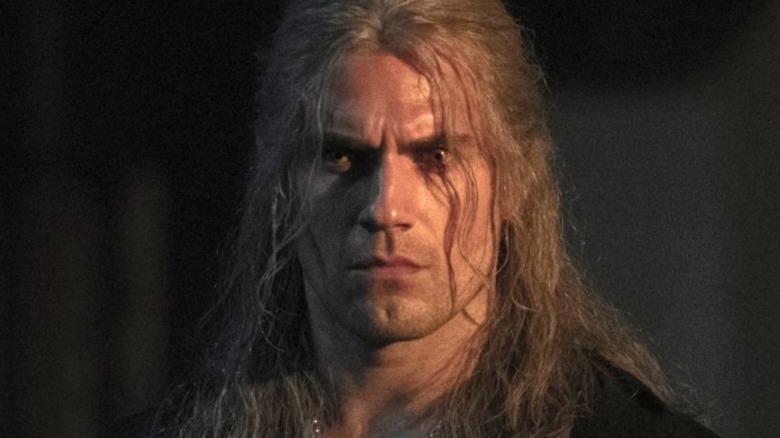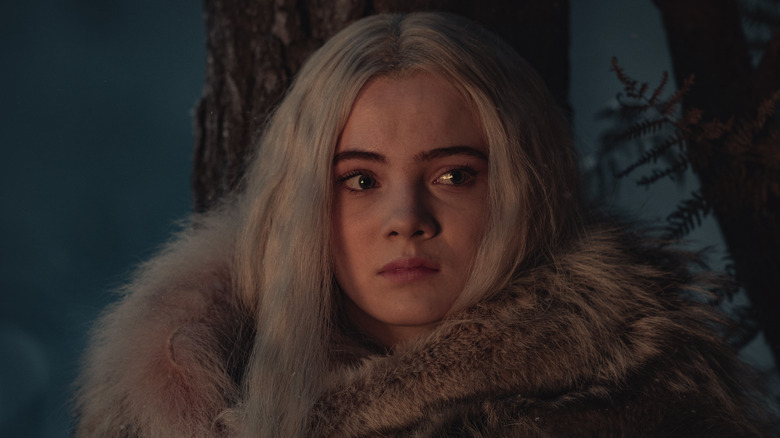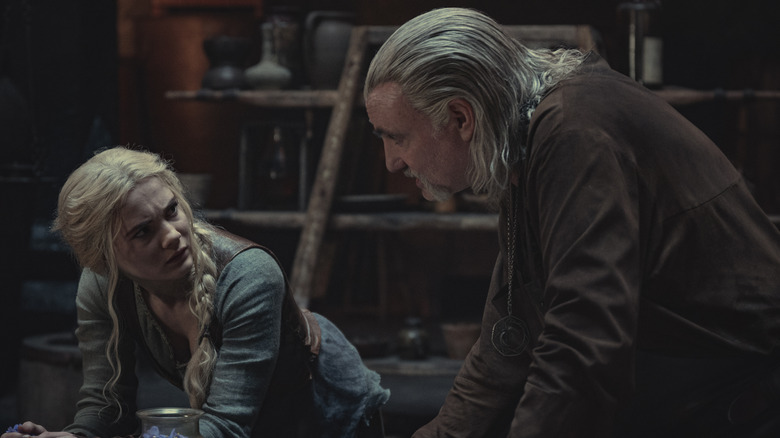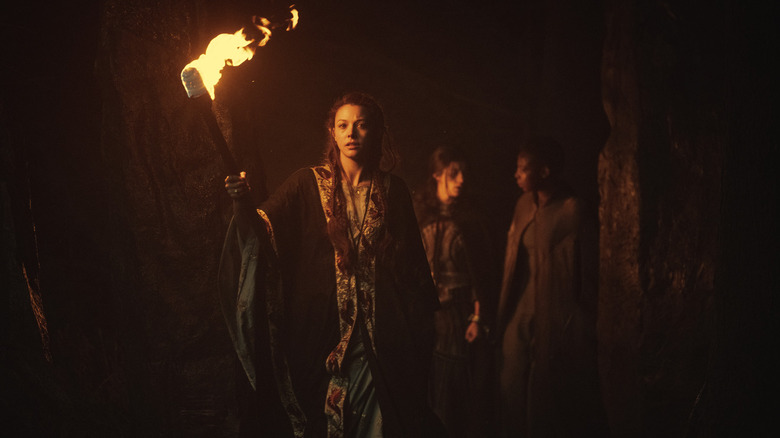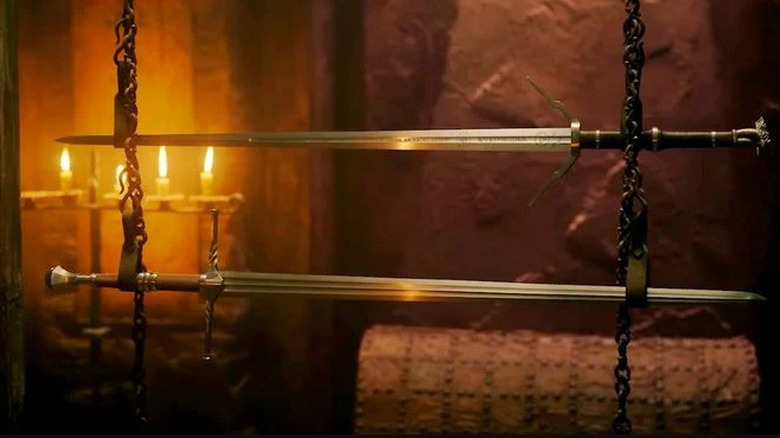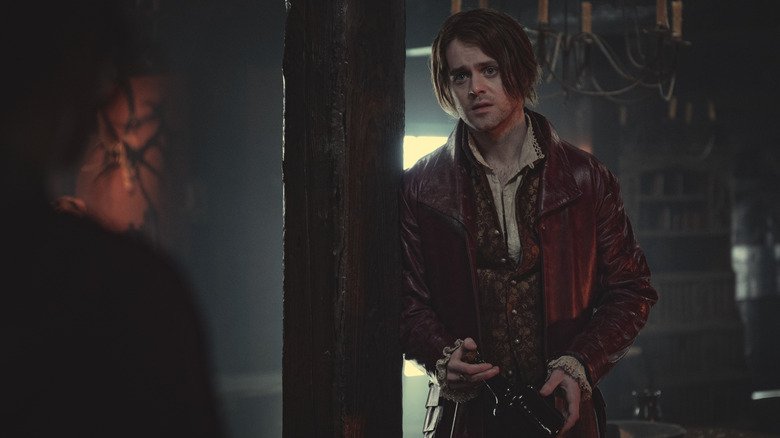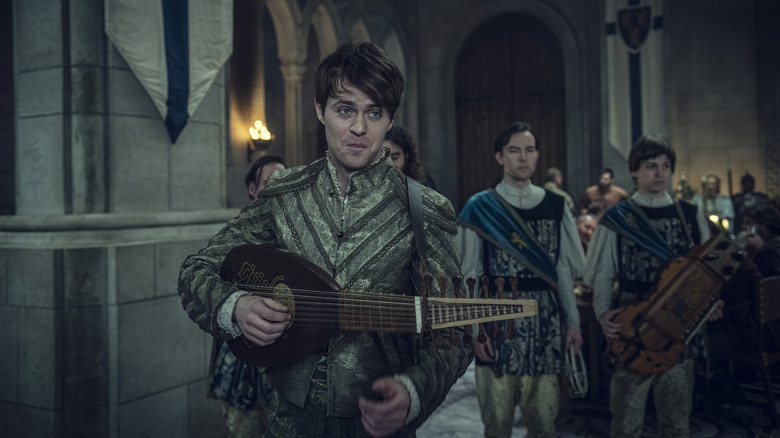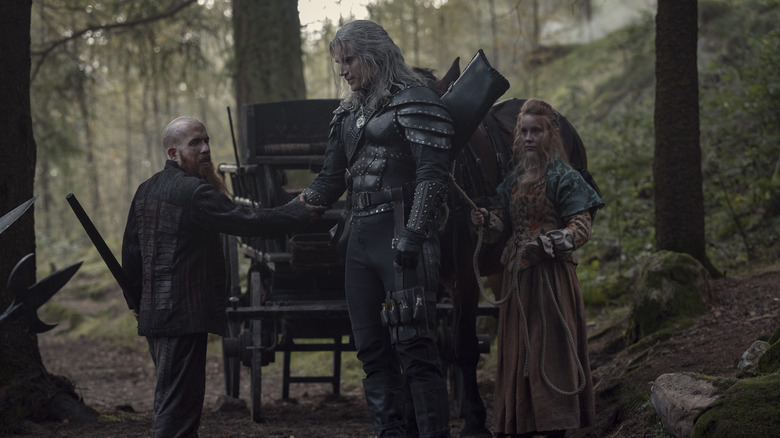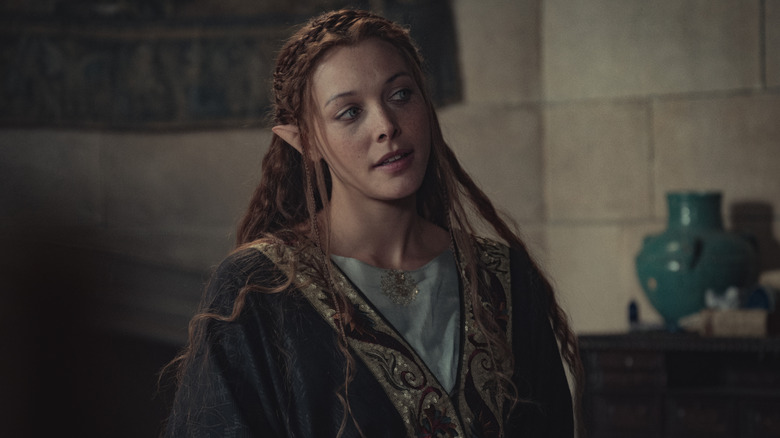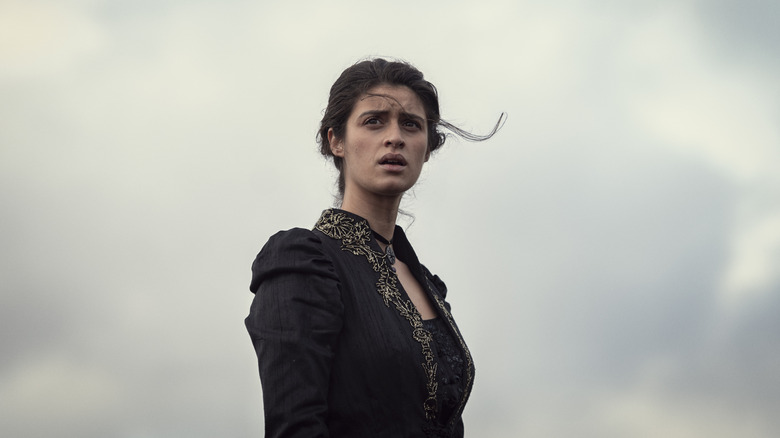Small Details You Missed In The Witcher Season 2
The following article contains spoilers for "The Witcher" Season 2.
The premiere of The Witcher Season 2 ends two long years of waiting to get back into the magical world of monster hunters, sorcerers, elves, and children of surprise. Based on the bestselling book series by Polish author Andrzej Sapkowski, Netflix's "The Witcher" live-action series follows Geralt of Rivia (Henry Cavill), a witcher who hunts monsters for coin and is plagued by a grand destiny he doesn't really want to believe in.
The second season is much easier to follow than the first and presents an adaptation of "Blood of Elves" and parts of "Time of Contempt." At the ending of Season 1, thousands die fighting against an invading Nilfgaard army at the Battle of Sodden Hill, Yennefer (Anya Chalotra) turns the tide of the conflict by using forbidden fire magic, and Geralt finally finds the princess of Cintra, Ciri (Freya Allan).
Ciri is at the center of Season 2, which focuses on her training as she tries to discover more about her unexplained powers. Geralt becomes a reluctant but dedicated father figure while Yennefer continues her quest for power. Meanwhile, war looms between the northern kingdoms of the Continent and the Nilfgaardians, who now have the persecuted but powerful elves on their side.
The new episodes are full of Easter eggs as well as nods to the books, games, and anime that came before it. Here are the small details you may have missed in "The Witcher" Season 2.
A dark twist on Beauty and the Beast
As a dark fantasy series, it's not surprising to see twists on fairytales motifs in "The Witcher." The first episode of Season 2 adapts and borrows the title of one of the series' most popular short stories, "A Grain of Truth," and features a dark love story reminiscent of the classic fairy tale "Beauty and the Beast." However, the beast in "The Witcher" is cursed after doing something much worse than being mean to an old woman at his castle door.
"A Grain of Truth" shows Geralt and Ciri meeting with Nivellen (Kristofer Hivju), who has been cursed with boar-like tusks, fur, and claws after he sacked a temple and raped a priestess. The cure for this curse, Nivellen explains, has something to do with "blood and love."
Nivellen is hiding another secret from Geralt – his vampiric lover Vereena lives in the abandoned castle with him and has been feasting on travelers who get too close. In the short story, Geralt first thinks Vereena is a nymph called a rusalka. However, she's actually a dangerous bruxa — a powerful creature who drinks blood and can turn into a giant bat. In "The Witcher" Season 2, Geralt fights Vereena to protect Ciri, but it's Nivellen who kills the bruxa to protect the witcher and the princess. This act of blood and love breaks Nivellen's curse, and he returns to his original human form.
Lines borrowed from Something More
A key dynamic in Season 2 of "The Witcher" is the relationship between Geralt and Cirilla, often simply referred to as Ciri, who is the princess of Cintra. When men become witchers, they are made infertile and, as such, do not expect to raise children. However, in Ciri, Geralt finds not only his "destiny" but a young girl whom he comes to consider his daughter.
Geralt and Ciri's paths have been intertwined since before she was born, thanks to the Law of Surprise. This ancient custom is followed when one person does a favor (usually a life-saving one) for another, with the reward being something the other person doesn't yet know that they have. In Ciri's case, she is a Child of Surprise. In Season 1, viewers see Geralt save her father's life and invoke the Law of Surprise. Ciri's father, Duny, doesn't yet know that her mother, Pavetta, is pregnant, and as a result, the unborn Ciri became Geralt's by right.
In Season 2's first episode, Ciri asks, "I'm your destiny?" and Geralt replies, "You're much more than that, Cirilla." The lines are lifted directly from "Sword of Destiny," specifically the book's final story, which shows Ciri and Geralt's first meeting. That story, "Something More," was adapted in the finale episode of season 1, titled "Much More."
Nods to Nightmare of the Wolf
As Season 2 of "The Witcher" prominently includes Vesemir (Kim Bodnia), it was bound to have nods to "The Witcher: Nightmare of the Wolf," the Netflix anime that describes Vesemir's origins and the brutal attack on Kaer Morhen that only he survived.
Though witchers age slowly, Vesemir is considered the oldest among them. The anime shows how he becomes a mentor for not only Geralt but also to Lambert, Eskel, and Remus – the four young boys who escaped the battle at the end of "Nightmare of the Wolf." In "The Witcher" Season 2, we finally see Eskel and Lambert all grown up and in live-action. Remus appears in Season 1 but is killed by a striga before Geralt arrives to break the creature's curse.
As part of Ciri's education, Vesemir explains a bit of the history behind Kaer Morhen and witchers' abilities. He tells her about fighting and living through the attack on Kaer Morhen, in which humans and magic-mutated monsters assault the stronghold in an attempt to eliminate the witchers. We also see an up-close shot of the massive tree in the middle of Kaer Morhen's hall where the medallions of fallen witchers hang.
Outside Kaer Morhen's keep, bones of humans and monsters still litter the ground, including a massive skeleton with a beak. It isn't confirmed, but it looks like it could be from the mutated griffin that attacks Vesemir in "Nightmare of the Wolf."
Baba Yaga and the Crones of The Witcher 3
In the Episode 2 scenes that are not set at Kaer Morhen, we follow a beat-up and broken down Yennefer, who is captured by Nilfgaard forces after the Battle of Sodden Hill. She reunites with former Aretuza classmate Fringilla (Mimi Ndiweni), a sorceress on the side of Nilfgaard. She also meets Francesca Findabair (Mecia Simson), an elven mage who is a leader among her people.
The three mages enter some ancient ruins, where they eventually find an illuminated straw house that begins to move on spindly legs. Inside, each of them meets a version of the Deathless Mother (Ania Marson), a character created for the series who serves as a mysterious antagonist throughout Season 2.
While this storyline is not part of Sapkowski's books, the house on stilted legs and the traits of the Deathless Mother parallel elements from "The Witcher 3: Wild Hunt" video game. The house, in particular, is reminiscent of the legend of Baba Yaga, a mythological character who lives in a straw cabin that roves around on chicken legs. In "The Witcher 3," the trio of witches known as the Crones are loosely based on the tales of Baba Yaga.
The Deathless Mother is also a bit reminiscent of Baba Yaga as she is shown shapeshifting into different people based on which mage she is interacting with. She's also similar to "The Witcher 3" villain Gaunter O'Dimm in that she preys on people's deepest desires and makes dangerous pacts with the promise of fulfilling their wishes.
Swords from The Witcher 3
While "The Witcher" series on Netflix is based on the stories and characters from Sapkowski's books, both seasons still include subtle nods to the wildly popular video games.
Season 2's second episode, titled "Kaer Morhen," is all about, well, Kaer Morhen and the start of Ciri's education and training there. In one scene, Vesemir gives Ciri a little tour of Kaer Morhen's vault, which prominently features weapons and armor from past witchers. The scene focuses on two gleaming swords, which dedicated fans might recognize.
These two weapons are direct nods to "The Witcher 3: Wild Hunt" video game. The top sword is the Viper Sword, a silver sword recognizable by the snake on the pommel and its unique bolt-shaped cross-guard. The bottom blade is steel and belongs to Geralt. In CD Projekt Red's "The Witcher" games, witchers typically carry two swords – a steel one for fighting non-magical beings and one coated in silver to slay monsters.
Jaskier's new look and sound
Besides Geralt, Jaskier the bard is one of the most popular characters in "The Witcher" series. In Season 1, Geralt and Jaskier part ways after an explosive argument that sees Geralt blaming the bard for all of his recent woes. However, Jaskier isn't doing so bad in Season 2, as he has developed a new look and sound that harken back to his portrayal in the books and games.
When we first see Jaskier in Episode 4, he's belting out his newest ballad, an epic breakup song with the hook "burn, butcher, burn." It's angsty, emotional, and hilariously recaps some of Season 1's adventures with the witcher from Jaskier's perspective. It may not be as catchy as "Toss a Coin," but it brings some comedic relief to a mostly grim Season 2.
In these scenes, Jaskier is also sporting longer hair, an unshaven face, and new attire that is much more in line with what he wore in the books and games. Along with a purple-hued leather coat, one brief scene shows him crooning while wearing a hat with an egret feather in it, bringing back one of his most memorable accessories.
Jokes about Season 1
"The Witcher's" second season is largely a grim affair, but there are some moments of levity thanks to the musical stylings and commentary by Jaskier the bard.
Jaskier's catchy new breakup ballad "Burn, Butcher, Burn" looks back at key moments he spent with Geralt in Season 1 and is a hit with the townspeople. One memorable scene shows a man telling Jaskier that his daughter is a big fan of his work, especially "the bit with the dragon." However, the man also notes that it "took me to the fourth verse to understand there were different timelines." This is, of course, a hilarious and self-aware nod to the convoluted timelines of Season 1 that is also representative of the show's updated storytelling approach.
"The Witcher" creators have been upfront about changes to the structure of the show for this season. Showrunner Lauren Schmidt Hissrich participated in an Ask Me Anything on Reddit in 2020 where she detailed how Season 2 would be much less confusing for those who were thrown off by Season 1. Second season Geralt also grunts much less than he did in Season 1, a trait the witcher himself Henry Cavill said he pushed hard to change, per Gizmodo.
Jaskier pokes fun at Geralt's grunt in Season 2's fourth episode, telling the mage Rience that "he grunts and I make songs." When the two reunite in Episode 7, Jaskier pushes Geralt to let him express his feelings when he says, "I'm talking to you; this is how this works."
Geralt's new armor
By the middle of Season 2, you'll notice Geralt has fashioned himself some shiny new armor. This new armor, made out of thick plates and leather, is both imposing and allows Geralt more flexibility while fighting monsters. In addition, the new armor also symbolizes a key evolution in Geralt's character and philosophy.
In a release from Netflix, Cavill said he had a big hand in redesigning the witcher's new armor, which "made it a lot easier for me to move and fight." Throughout the creation of both seasons, Cavill has been open about his love for "The Witcher" franchise – the books, games, and show – and about his influences on making changes to Geralt's look and character through all 16 episodes.
Geralt's new armor isn't just about the character's mobility. In the same release, Cavill explained that this new armor symbolizes Geralt's comfort in remaining in one place for a longer period of time. Typically, Geralt is a loner on the move, with no opportunities to fashion new armor. However, the time he spends in Kaer Morhen with Ciri, Eskel, and Lambert shows his belief in the safety of the witcher stronghold and his trust in his fellow monster hunters.
Symbolic white roses
In Episode 6, titled "Dear Friend...", a very pregnant Francesca walks with the mage Frangilla in the gardens of Cintra. The two sorcerers have become friends and clearly care for one another but have very different goals. While Frangilla serves Nilfgaard and the mysterious "White Flame" – Emperor Emhyr – Francesca's chief concern is the safety of her unborn child and her people, the elves.
While the two walk, Francesca stops to bring some white roses back to life and picks a few for her baby's bassinet. She also tells Frangilla about discovering her magical powers following the death of her mother, with whom she loved to pick flowers. In the book "Blood of Elves," white roses are symbols of the elven heroine Aelirenn - also called the White Rose of Shaerrawedd. Aelirenn is best known for leading a last desperate battle against the humans, who were quickly overcoming her people.
In the books, white roses still grow at the ruins of Shaerrawedd, and Francesca's revitalization of the flowers is a way to acknowledge and honor Aelirenn's sacrifice.
A dear friend
The title of Episode 6 is "Dear Friend," which is a direct reference to a letter Geralt writes to Yennefer in "Blood of Elves" when he asks for her help with Ciri. In the book, quite some time has passed since Geralt and Yennefer last saw one another. Just like when they part ways in Season 1 of "The Witcher," the witcher and the mage do not leave one another on the best of terms.
In the book, Geralt decides to address a letter to Yennefer with "Dear friend ..." and Yennefer pens a biting response to him for calling her such. Episode 6 contains an equally awkward and hilarious scene when Geralt and Yennefer reunite at the Temple of Melitele. When Ciri barges into his room and sees Yennefer, she asks who she is, to which he replies, "A dear friend."
Yennefer glares at Geralt, understandably irritated at him for labeling "the most powerful mage he's ever known" and his former lover as simply "A dear friend."
